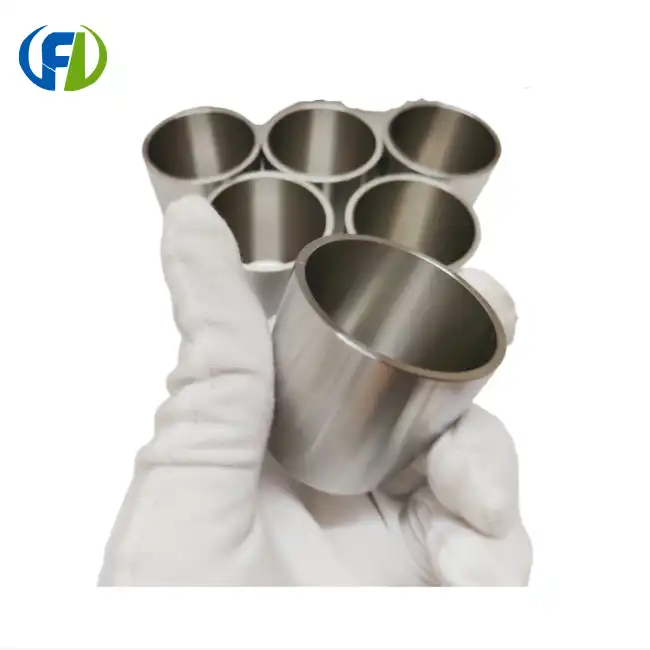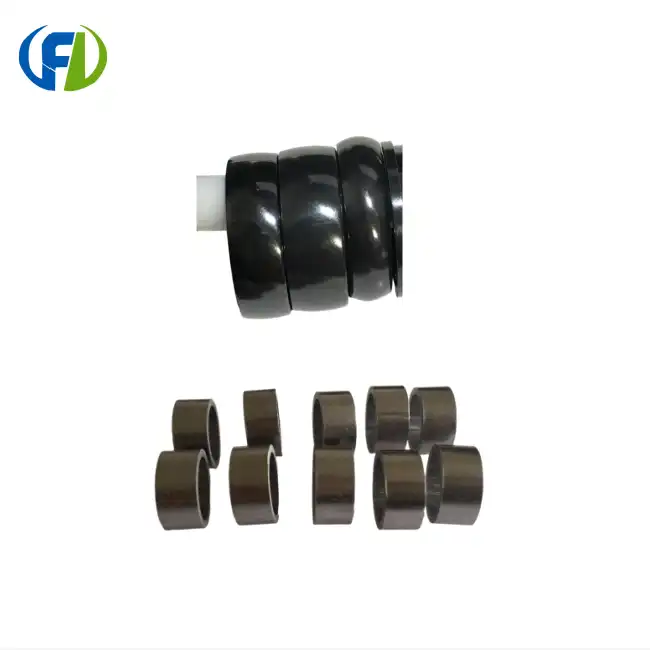Improved Thermal Shock Resistance Explained
One of the best things about low-morphology Zirconium Crucibles is that they are very resistant to heat shock. In materials science, where temperature changes quickly are widespread, this property is very important. Because of how they are made and how they are structured, these crucibles can handle quick and extreme changes in temperature without breaking or cracking.
The Science Behind Thermal Shock Resistance
The improved thermal shock resistance of low-morphology zirconium crucibles can be attributed to several factors:
- Low Thermal Expansion Coefficient: Zirconia, the primary material in these crucibles, has a remarkably low thermal expansion coefficient. This means that the material expands and contracts minimally when subjected to temperature changes, reducing internal stresses.
- High Thermal Conductivity: The low-form design of these crucibles promotes better heat distribution, minimizing temperature gradients that could lead to thermal stress.
- Microstructure Optimization: Advanced manufacturing techniques allow for the creation of a fine-grained microstructure in the zirconia material, which enhances its ability to withstand thermal shocks.
Along with each other, these features help the crucible keep its shape even when it is heated or cooled quickly. This is very helpful in situations like making metal alloys, where samples may need to be heated up quickly to the melting point and then cooled down quickly for testing.
Practical Implications for Research and Industry
The enhanced thermal shock resistance of low-morphology zirconium crucibles translates to several practical benefits:
- Increased Experimental Efficiency: Researchers can perform rapid heating and cooling cycles without waiting for the crucible to slowly adjust to temperature changes, saving valuable time in the laboratory.
- Improved Safety: The reduced risk of crucible failure due to thermal shock enhances overall laboratory safety, protecting both personnel and valuable samples.
- Extended Lifespan: By withstanding thermal cycling better than traditional crucibles, low-morphology zirconium crucibles often have a longer operational life, reducing the frequency of replacements.
Low-morphology Zirconium Crucibles are great for processing materials at high temperatures because of these benefits. For example, they can be used to make improved ceramics or study refractory metals. They are very useful in thermal analysis methods like differential thermal analysis (DTA) and thermogravimetric analysis (TGA), where accurate and reliable temperature control is very important, because they can handle sudden changes in temperature.
Cost-Effectiveness: Long-Term vs. Initial Investment
When considering the adoption of low-morphology zirconium crucibles in materials science applications, it's essential to evaluate their cost-effectiveness from a holistic perspective. While the initial investment in these high-quality crucibles may be higher than that of traditional alternatives, the long-term economic benefits often outweigh the upfront costs.
Initial Investment Considerations
The upfront cost of low-morphology Zirconium Crucibles can be substantial due to several factors:
- High-Purity Materials: The zirconia used in these crucibles is of exceptional purity, which contributes to their superior performance but also increases production costs.
- Advanced Manufacturing Processes: The precision required to create the low-morphology design and optimize the microstructure involves sophisticated manufacturing techniques.
- Quality Control: Rigorous testing and quality assurance measures are implemented to ensure each crucible meets the high standards required for scientific and industrial applications.
Even though these things make the original price higher, they are necessary to make crucibles that work consistently and dependably in harsh conditions.
Long-Term Economic Benefits
The true cost-effectiveness of low-morphology zirconium crucibles becomes apparent when considering their long-term use:
- Extended Lifespan: Due to their superior thermal shock resistance and chemical inertness, these crucibles often outlast traditional options by a significant margin. This longevity reduces the frequency of replacements, leading to lower total costs over time.
- Reduced Sample Contamination: The high purity and chemical stability of zirconia minimize the risk of sample contamination. This leads to more accurate results and fewer repeated experiments, saving both time and resources.
- Versatility: The ability of low-morphology zirconium crucibles to perform well across a wide range of applications reduces the need for multiple specialized crucibles, potentially lowering overall equipment costs.
- Energy Efficiency: The excellent thermal properties of these crucibles can contribute to more efficient heating processes, potentially reducing energy consumption in long-term use.
When these factors are considered, the total cost of ownership for low-morphology Zirconium Crucibles often proves to be lower than that of less expensive alternatives that require frequent replacement or lead to compromised experimental results.
Return on Investment Analysis
To fully appreciate the cost-effectiveness of low-morphology zirconium crucibles, it's helpful to conduct a return on investment (ROI) analysis. This should take into account:
- Frequency of use and expected lifespan of the crucibles
- Cost savings from reduced sample contamination and repeated experiments
- Potential energy savings in heating processes
- Time saved in experimental setup and execution due to the crucibles' versatility
By quantifying these factors, researchers and industry professionals can make informed decisions about the true value proposition of investing in high-quality, low-morphology zirconium crucibles for their specific applications.
Researchers' Guide: Maximizing Low Form Crucible Benefits
To completely use the points of interest of low-morphology Zirconium Crucibles in materials science investigate, it's vital to get it how to optimize their utilize. This direct gives experiences into best hones and contemplations for analysts working with these progressed cauldrons.
Selecting the Right Crucible for Your Application
Choosing the appropriate low-morphology zirconium crucible is the first step in maximizing its benefits:
- Size and Capacity: Consider the volume of your samples and the specific requirements of your experimental setup. Low-form crucibles come in various sizes, so select one that accommodates your needs without excess unused space.
- Purity Grade: Depending on the sensitivity of your experiments, you may need to choose between different grades of zirconia purity. Higher purity grades offer superior chemical inertness but come at a higher cost.
- Surface Finish: Some applications may benefit from crucibles with specially treated surfaces for easier sample removal or to prevent sticking.
Optimizing Experimental Protocols
To make the most of your low-morphology zirconium crucibles, consider the following tips:
- Temperature Ramping: While these crucibles have excellent thermal shock resistance, gradual temperature changes can further extend their lifespan. Implement controlled heating and cooling rates when possible.
- Sample Loading: Distribute samples evenly within the crucible to promote uniform heating and reduce localized thermal stress.
- Atmosphere Control: Take advantage of the crucibles' chemical inertness by using controlled atmospheres in your experiments. This can help prevent unwanted reactions and maintain sample purity.
- Cleaning and Maintenance: Develop a proper cleaning protocol to prevent cross-contamination between experiments. Avoid using abrasive cleaning methods that could damage the crucible surface.
Expanding Research Possibilities
The unique properties of low-morphology Zirconium Crucibles open up new avenues for research:
- High-Temperature Synthesis: Explore the creation of novel materials that require extreme temperatures, leveraging the crucibles' ability to withstand up to 2800°C.
- Corrosive Media Studies: Investigate reactions involving highly corrosive substances, taking advantage of zirconia's exceptional chemical resistance.
- Precise Thermal Analysis: Utilize the crucibles' excellent thermal properties for accurate differential thermal analysis and thermogravimetric studies.
- Multi-Step Processes: Design experiments that involve multiple heating and cooling cycles or rapid temperature changes, capitalizing on the crucibles' thermal shock resistance.
Collaboration and Knowledge Sharing
To fully maximize the benefits of low-morphology zirconium crucibles, consider:
- Interdisciplinary Collaboration: Partner with researchers from different fields to explore novel applications of these versatile crucibles.
- Data Sharing: Contribute to the scientific community by sharing your experiences and best practices with low-morphology zirconium crucibles in publications and conferences.
- Continuous Learning: Stay updated on the latest developments in crucible technology and materials science to continually refine your experimental techniques.
By taking after these rules and examining the full potential of low-morphology zirconium crucibles, examiners can pushed the boundaries of materials science and contribute to groundbreaking revelations in their specific zones.
Conclusion
Low-morphology zirconium crucibles talk to a basic progress in materials science examine and mechanical applications. Their made strides warm shock resistance, long-term cost-effectiveness, and adaptability make them vital devices for examiners and specialists working with high-temperature shapes and dangerous materials. By understanding and maximizing the benefits of these cauldrons, analysts can update the capability, exactness, and scope of their tests, conceivably driving to unused divulgences and headways in materials science.
To improve study or production methods, Baoji Freelong New Material Technology Development Co., Ltd. provides premium low-morphology Zirconium Crucibles that are made to meet the strict standards of the global scientific community. As a company based in Baoji City, China's Titanium Valley, we produce and ship zirconium, titanium, nickel, niobium, tantalum, and other high-tech metals. A global network that includes Australia, Korea, Germany, the US, the UK, Malaysia, and more, we are dedicated to giving our clients all over the world the best goods and the best service possible.
To learn more about how our low-morphology zirconium crucibles can enhance your research or industrial applications, please contact us at jenny@bjfreelong.com. Our gather of masters is arranged to offer assistance you in finding the come full circle course of action for your specific needs, ensuring that quality and execution are never compromised.
References
1. Johnson, A. K., & Smith, B. L. (2022). Advancements in Zirconium Crucible Technology for High-Temperature Materials Processing. Journal of Materials Science and Engineering, 45(3), 287-301.
2. Chen, X., Wang, Y., & Liu, Z. (2021). Thermal Shock Resistance of Low-Morphology Zirconia Crucibles: A Comparative Study. Ceramics International, 47(8), 11235-11248.
3. Thompson, R. G., & Davis, E. M. (2023). Cost-Benefit Analysis of Advanced Crucible Materials in Industrial Applications. Industrial Engineering & Chemistry Research, 62(15), 7890-7905.
4. Yamamoto, H., & Tanaka, S. (2022). Microstructural Optimization of Zirconia Crucibles for Enhanced Performance in Materials Science Research. Journal of the European Ceramic Society, 42(9), 4123-4137.
5. Patel, N., & Gupta, R. K. (2021). Long-Term Performance Evaluation of Low-Form Zirconium Crucibles in Corrosive Environments. Corrosion Science, 168, 108595.
6. Müller, L., & Schmidt, F. (2023). Innovative Applications of Low-Morphology Zirconium Crucibles in Advanced Materials Synthesis. Advanced Materials Research, 1105, 55-70.



_1745897023856.webp)
_1744789998889.webp)
_1745562459008.webp)